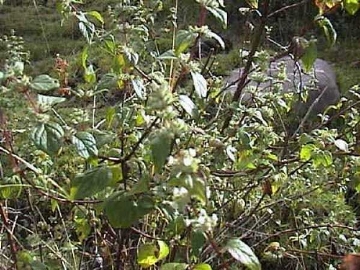Muña Muña - Andean Mint

Common Names: Muña Muña, Andean Mint, Minthostachys setosa, Muna-Muna, Muña-Muña, South American Mountain Mint, Andean Wild Mint, Huaychac, Muna, International: Minthostachys, Latin: Minthostachys setosa, Origin: Andes
Latin Name: Minthostachys setosa
Origin: South America
Short Introduction
Muña Muña is a high-altitude herb found at elevations around 3,000 meters above sea level. It grows on dry, rocky slopes throughout the Andes, stretching from northern Venezuela and other countries south to Argentina. Many growers are involved in the trade of this herb; however, cultivating it in the Czech Republic is not feasible.
Detailed Description
An herb utilized throughout South America as a natural antibiotic.
Botanical Information
Muña Muña, also known as Andean Mint (Minthostachys setosa), is a perennial herb that can reach up to 2 meters in height, with a bushy appearance due to its branching stems. Its leaves are ovate, elliptical, delicate, and may be either smooth or slightly hairy. The stems are lightly covered with fine hairs. Small, white, highly aromatic flowers grow in dense clusters, releasing a distinctive essential oil fragrance.
Origin and Distribution
Muña Muña is indigenous to the Andes, with a native range that extends from the northern borders of Ecuador and Venezuela through Bolivia southwards into central Argentina. It thrives in high-altitude Andean regions.
Usage / Dosage
Muña Muña has widespread traditional uses and is highly valued in ethnomedicine for its rich content of bioactive compounds, many of which are commonly extracted for use in Western medicine as well. It is particularly rich in essential oils (notably menthone, thymol, carvone, and others), which lend themselves as flavoring agents and effective additives in remedies intended to address digestive or respiratory complaints.
In southern Peru, Muña Muña is also utilized to protect foods from small pests (mainly insects), making it important in local agriculture. Due to its useful attributes, the plant is now commercially cultivated on a large scale in Argentina and Peru, with researchers working to domesticate and conserve wild forms by developing optimal growth conditions and breeding suitable varieties for commercial production.
Traditionally, Muña Muña is recommended for a variety of respiratory issues, from colds, bronchial inflammation, and infectious diseases of the respiratory tract to bronchitis and asthma. These uses are rooted in folk knowledge but are supported by the scientifically recognized efficacy of its key constituents, which are backed by clinical studies. The herb is also used to relieve inflammation in the paranasal sinuses.
Muña Muña is equally popular for digestive complaints, especially in cases of colic, constipation, and bloating. Its essential oils help capture and dissolve gas bubbles, thereby alleviating intestinal cramps. By the same mechanism, the herb helps with breathing difficulties and is therefore a valued supplement in managing colds and influenza (often combined in traditional practice with Wira-Wira and Cat’s Claw).
Folk healers recommend Muña Muña extracts in compresses to soothe painful joint inflammations, and it is embraced for use in whole-body detoxification. In Peru, Muña Muña is used as an analgesic, especially for painful menstruation. When combined with sage, it is the first choice against parasitic diseases (particularly of the digestive tract) due to its insecticidal and larvicidal properties. Muña Muña is recognized in Peru as a natural antibiotic.
Active Compounds
The spectrum of constituents in Muña Muña is rich and diverse. The essential oil fraction includes menthol and its esters, menthone, isomenthone, pulegone, caryophyllene, limonene, thymol, flavones, terpenes (such as geraniol, cineole, linalool), alcohols, and tannins, as well as minerals like calcium and phosphorus, and vitamin B1.
Traditional Dosage
For pure dried herb, use 1 tablespoon per 1 liter of cold water, bring to a boil and simmer for about 5 minutes. Strain and drink 1 glass (200 ml) of the decoction three times daily. Not recommended for children under 3 years old, nursing or pregnant women due to lack of safety data. Similarly, it is not recommended for individuals with diabetes.
